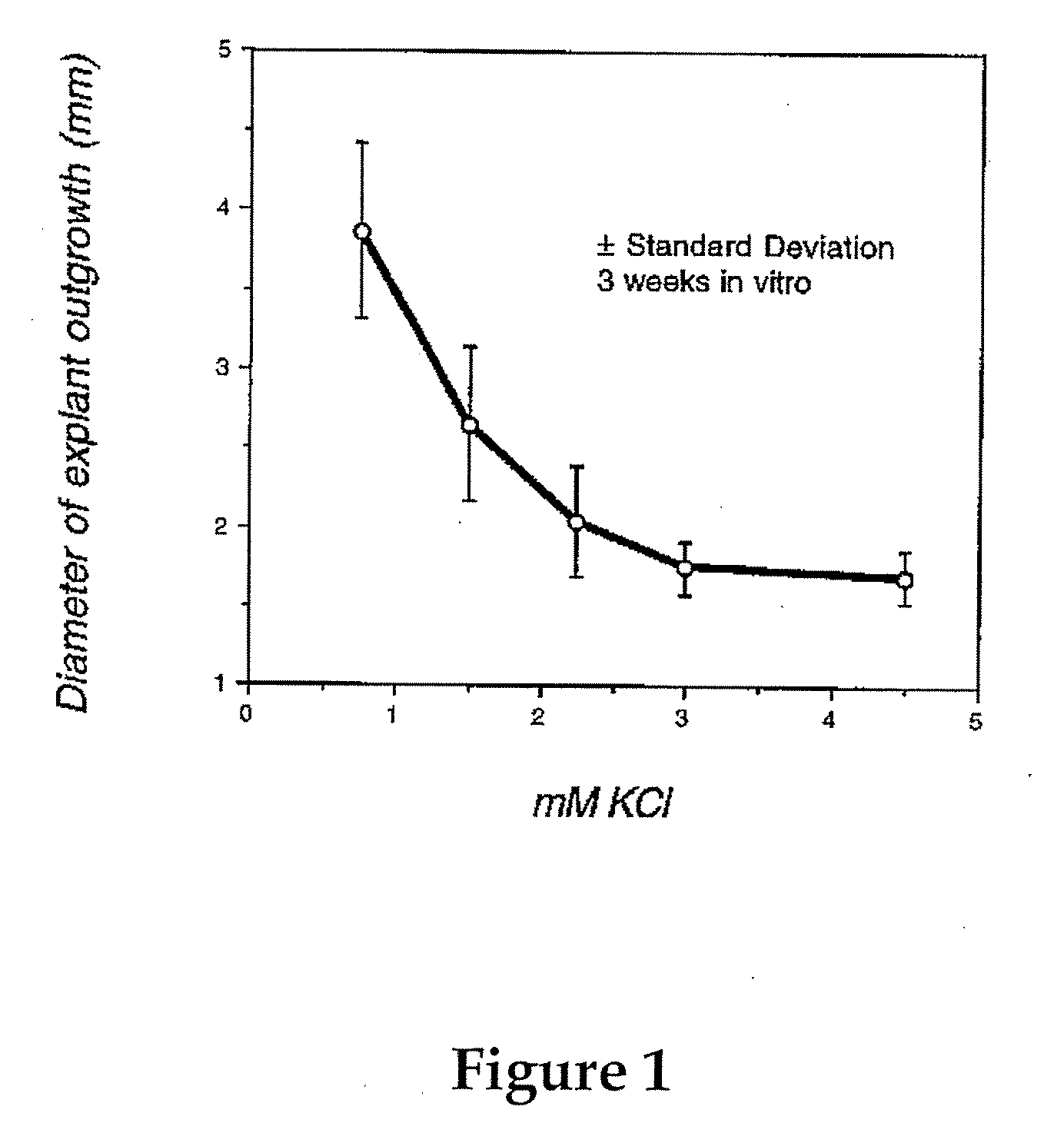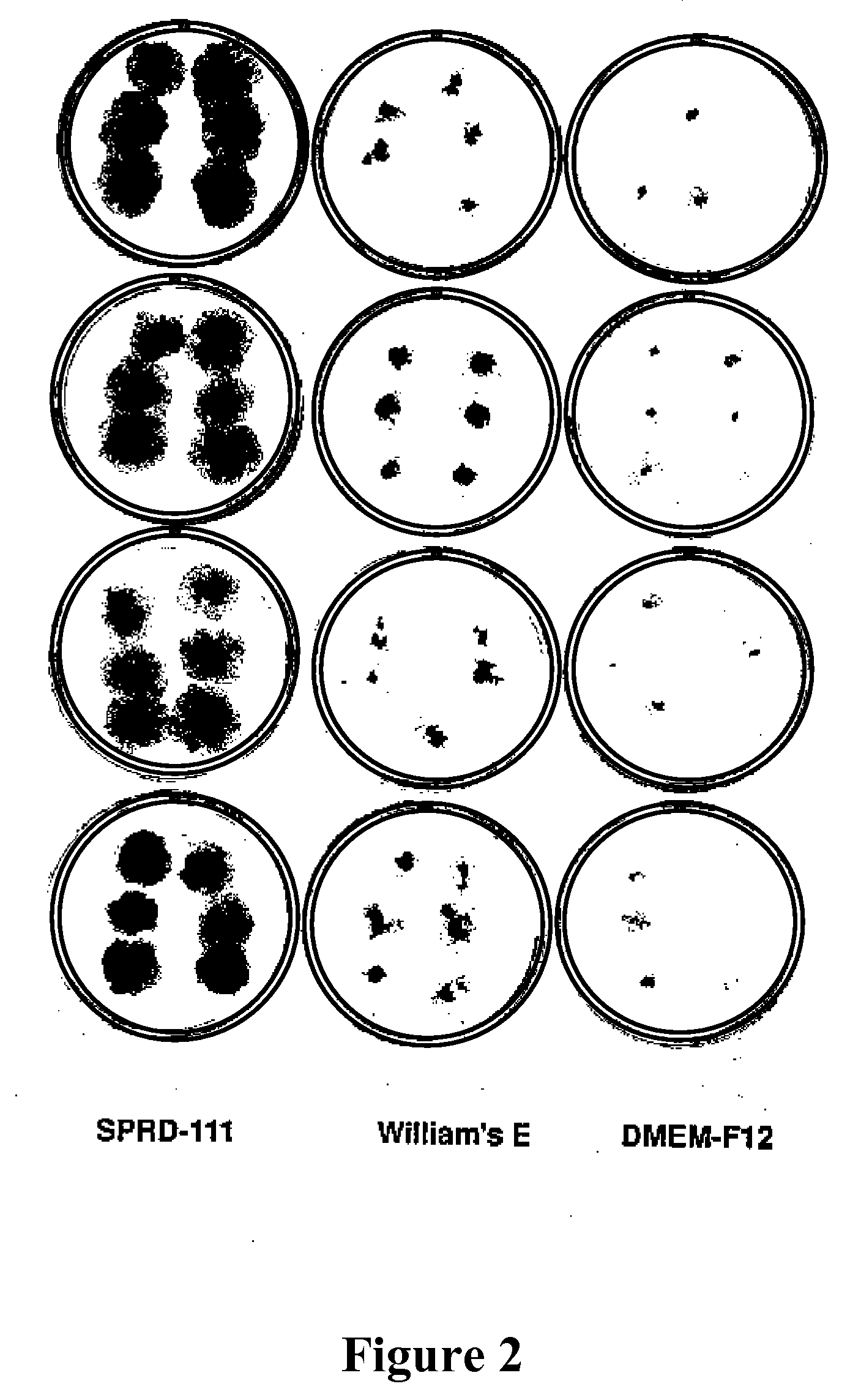Methods for in vitro growth of hair follicles
a technology of in vitro growth and hair follicles, which is applied in the field of methods for in vitro growth of hair follicles, can solve the problems that the cultivation of epidermal cells, including hair follicle cells, is difficult to achieve in the absence of unpurified biological components
- Summary
- Abstract
- Description
- Claims
- Application Information
AI Technical Summary
Benefits of technology
Problems solved by technology
Method used
Image
Examples
example 1
In Vitro Isolation and Expansion of Cell Populations from Hair-Bearing Human Skin
[0093]Alpha-6 integrin+ / CD34+ keratinocyte stem cells from the hair follicle bulge; mesenchymal cells from the follicular papillae and connective tissue sheaths; and undifferentiated mesenchymal sphere-forming stem cells are isolated by microdissection and by sphere-formation, respectively, according to published procedures. The expanded cell culture populations are compared with the freshly isolated cells using several physical and functional determinants of each population, such as expression of cytokeratins, nestin, and other markers, and by in vitro assay for colony formation. The follicle-forming potential of recombined primary and cultured cells is tested on de-epidermized dermis and by in vitro co-culture. Culture conditions can be optimized to achieve long-term maintenance of stem cell and follicle-forming properties of each follicular component.
example 2
Assessment of the Hair-Growth Potential of Human Skin Explant Cultures
[0094]Explants of hair-bearing human skin (obtained from discarded specimens of hair-bearing human skin) are established on Transwell inserts and cultured at the air-liquid interface. Hair length is measured weekly using a calibrated dissecting microscope. Additionally, at bi-weekly intervals, several explants are removed and processed for light microscopy to assess the integrity of the follicles. Explants of human skin can also be established on Matrigel and the keratinocyte and fibroblast outgrowth monitored for formation of tubes and follicle-like structures. At bi-weekly intervals, several explants and their outgrowths are removed for histology. Culture conditions can be optimized such that the hair-bearing explants of human skin will demonstrate hair growth in culture.
example 3
Concentration of Sodium, Potassium, Calcium and Magnesium in Basal Media
[0095]SPRD-111
[0096]SPRD-111 contains the following concentrations of compounds containing sodium, potassium, calcium and magnesium: sodium acetate (CH3CO2Na.3H2O), 84.5 mg / ml; sodium pyruvate (C3H3NaO3), 11.5 mg / ml; sodium phosphate (Na2HPO4), 92.0 mg / ml; sodium chloride (NaCl), 2990.70 mg / ml; sodium bicarbonate (NaHCO3), 321.96 mg / ml; sodium sulfate (NaSO4), 1.14 mg / ml; potassium chloride (KCl), 58.94 mg / ml; magnesium chloride (MgCl2-6H2O), 29.16 mg / ml; calcium chloride (CaCl2), 48.41 mg / ml. The sodium to potassium ratio (Na+ / K+) ratio of SPRD-111 is 59.4.
[0097]Williams Medium E
[0098]Williams Medium E contains the following amounts of compounds containing sodium, potassium, calcium and magnesium: sodium pyruvate (C3H3NaO3), 5.23 mg / ml; sodium chloride (NaCl), 2676.25 mg / ml; sodium bicarbonate (NaHCO3), 602.31 mg / ml; sodium phosphate (NaH2PO4.H2O), 20.13 mg / ml; potassium chloride (KCl), 210.81 mg / ml; magnesium ...
PUM
| Property | Measurement | Unit |
|---|---|---|
| concentration | aaaaa | aaaaa |
| concentration | aaaaa | aaaaa |
| concentration | aaaaa | aaaaa |
Abstract
Description
Claims
Application Information
 Login to View More
Login to View More - R&D
- Intellectual Property
- Life Sciences
- Materials
- Tech Scout
- Unparalleled Data Quality
- Higher Quality Content
- 60% Fewer Hallucinations
Browse by: Latest US Patents, China's latest patents, Technical Efficacy Thesaurus, Application Domain, Technology Topic, Popular Technical Reports.
© 2025 PatSnap. All rights reserved.Legal|Privacy policy|Modern Slavery Act Transparency Statement|Sitemap|About US| Contact US: help@patsnap.com



